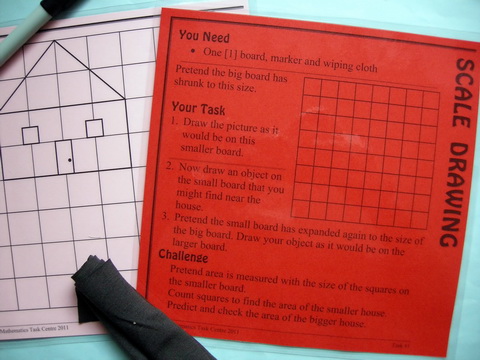
Scale DrawingTask 41 ... Years 2 - 7SummaryA shape is drawn on one grid and students are asked to redraw it on a grid with a different scale. They are practising several measurement skills in a non-threatening environment. Using the pen on the laminated board means mistakes are easily erased. Soon students become confident with the process and are able to draw a more permanent copy on graph paper.Note: The laminated board (top right) was omitted from all eTask Packs purchased before the end of December 2019. Save and print from here and include with your other files. |
Materials
Content
|

IcebergA task is the tip of a learning iceberg. There is always more to a task than is recorded on the card. |
|
Whole Class InvestigationTasks are an invitation for two students to work like a mathematician. Tasks can also be modified to become whole class investigations which model how a mathematician works. |
Use 1cm square line paper and the file designed for the laminated board in the task. Use the challenges on the card and in the Iceberg above to guide the initial lesson. Prepare some 2cm grids printed on stiffish card and invite students to create their own scale drawing challenge and record it on these grids. Creations are first designed on graph paper before being recorded on the card. They can be buildings, vehicles, animal caricatures or anything else, but keep them simple. Collect and laminate the drawings. When you have 15 laminated drawings they make a class set. Give one to each pair with a sheet of 1cm graph paper and ask them to reproduce the drawing using one length on the graph paper to match one on the original drawing. Are the two drawings the same size? Explore and explain. One key element is that the unit of length on the original drawing is not the same as the unit of length on the paper drawing, but they are connected. One unit on the original equals two on the paper drawing. This is the scale. Original : Copy = 1 : 2On some maps (especially Army Survey maps) you find scale statements like 1:1000 or 1:10,000. What could these mean? Suppose the original grids for the students' laminated drawings had been 3cm squares, how would the scale be written?
At this stage Scale Drawing does not have a matching lesson on Maths300. |
Is it in Maths With Attitude?Maths With Attitude is a set of hands-on learning kits available from Years 3-10 which structure the use of tasks and whole class investigations into a week by week planner. |
The Scale Drawing task is an integral part of:
|